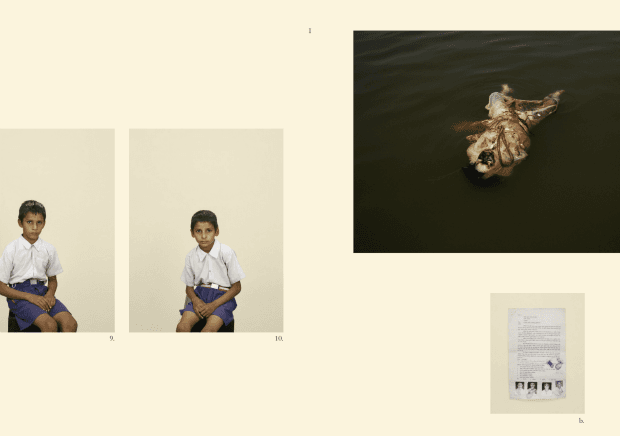Taryn Simon: Chapters of Invisible Lives
Taryn Simon‘s photographs are crisp to the point of being stark, stripped of all but the most essential elements. She documents places and things that are normally kept far from view: items detained at customs, radioactive capsules at a nuclear waste storage facility, the art collection of the CIA. In 2007, she told Studio 360 that “[at] a time when our country was invested in finding secrets outside of its borders, whether it be weapons of mass destruction or to understand other cultures, and I wanted to look inward and find those hidden secrets within our borders.” (Listen to the full story below.)
Her latest work focuses on families — “bloodlines” — and tries to trace how time, events, and choices shape their fates. Nine bloodlines are on view at New York’s Museum of Modern Art in the exhibition Taryn Simon: A Living Man Declared Dead and Other Chapters.
The bloodline’s stories are told in “chapters” made up of three panels. The central panel includes text describing the narrative of each group. It’s flanked by two more panels, one that holds a photo of each living relation and one that frames “footnote images,” photographic evidence taken by Simon to illustrate fragments of the story. These third panels, collages of images and documents, are the most engaging part of each chapter. They fall somewhere between a scrapbook and an archive: the image is shot with a dispassionate eye of a researcher, but contains images that are deeply personal.

Above, a chapter documents a family from India. Multiple generations are pictured, but some of the family members are listed as dead in official documents. The chapter tells the story of Shivdutt Yadav, who discovered he was listed as dead on a visit to the local land registry office. Relatives had bribed officials to list Yadav as dead so they could inherit the family’s ancestral property.

In the third panel, Simon gathers photos and a letter to reflect that story. Simon includes a letter to the chief judicial magistrate of Azamgarh requesting that Yadav be recognized as living and the rightful owner of his property. A corpse with leprosy, discolored and pale, floats in the murky water of the Ganges River, the same river where Yadav’s father was cremated.
Simon also presents three generations of a Chinese family, the descendants of Hitler’s personal legal advisor, and even a family of rabbits. A portrait of children from a Ukrainian orphanage stands next to a photograph of their home: fifteen beds with matching yellow coverlets are packed in a cheery, if cramped, room.
Simon has traveled around the world pursing subject for her work. Some sites have required extensive paperwork for visitor and photography permits. And for the most part, she’s been successful. Except for one location: Disney World. “I was trying to get into their underground tunnel facility; finally they sent me a fax that said ‘During these violent times its important to give people a fantasy that they can escape to. … In the end, the fax is so much more valuable as a piece of art than anything I would have photographed, so that fax is the closing page in the book.”
Taryn Simon: A Living Man Declared Dead and Other Chapters is on view at MoMA through September 3, 2012.
Taryn Simon on Studio 360: April 4, 2008
Simon talks about her project An American Index of the Hidden and Unfamiliar.
Every day, reporters and producers at The World are hard at work bringing you human-centered news from across the globe. But we can’t do it without you. We need your support to ensure we can continue this work for another year.
Make a gift today, and you’ll help us unlock a matching gift of $67,000!
